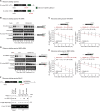Human DDX6 regulates translation and decay of inefficiently translated mRNAs
- PMID: 38989862
- PMCID: PMC11239181
- DOI: 10.7554/eLife.92426
Human DDX6 regulates translation and decay of inefficiently translated mRNAs
Abstract
Recent findings indicate that the translation elongation rate influences mRNA stability. One of the factors that has been implicated in this link between mRNA decay and translation speed is the yeast DEAD-box helicase Dhh1p. Here, we demonstrated that the human ortholog of Dhh1p, DDX6, triggers the deadenylation-dependent decay of inefficiently translated mRNAs in human cells. DDX6 interacts with the ribosome through the Phe-Asp-Phe (FDF) motif in its RecA2 domain. Furthermore, RecA2-mediated interactions and ATPase activity are both required for DDX6 to destabilize inefficiently translated mRNAs. Using ribosome profiling and RNA sequencing, we identified two classes of endogenous mRNAs that are regulated in a DDX6-dependent manner. The identified targets are either translationally regulated or regulated at the steady-state-level and either exhibit signatures of poor overall translation or of locally reduced ribosome translocation rates. Transferring the identified sequence stretches into a reporter mRNA caused translation- and DDX6-dependent degradation of the reporter mRNA. In summary, these results identify DDX6 as a crucial regulator of mRNA translation and decay triggered by slow ribosome movement and provide insights into the mechanism by which DDX6 destabilizes inefficiently translated mRNAs.
Keywords: CCR4-NOT complex; DDX6; biochemistry; chemical biology; chromosomes; codon optimization; gene expression; human; mRNA decay; ribosome stalling.
© 2024, Weber and Chang.
Conflict of interest statement
RW, CC No competing interests declared
Figures









Update of
- doi: 10.1101/2023.10.30.564346
- doi: 10.7554/eLife.92426.1
- doi: 10.7554/eLife.92426.2
Similar articles
-
The DEAD-Box Protein Dhh1p Couples mRNA Decay and Translation by Monitoring Codon Optimality.Cell. 2016 Sep 22;167(1):122-132.e9. doi: 10.1016/j.cell.2016.08.053. Epub 2016 Sep 15. Cell. 2016. PMID: 27641505 Free PMC article.
-
DDX6 (Rck/p54) is required for efficient hepatitis C virus replication but not for internal ribosome entry site-directed translation.J Virol. 2010 Jul;84(13):6810-24. doi: 10.1128/JVI.00397-10. Epub 2010 Apr 14. J Virol. 2010. PMID: 20392846 Free PMC article.
-
Human DDX6 effects miRNA-mediated gene silencing via direct binding to CNOT1.RNA. 2014 Sep;20(9):1398-409. doi: 10.1261/rna.045302.114. Epub 2014 Jul 17. RNA. 2014. PMID: 25035296 Free PMC article.
-
Ribosome dynamics and mRNA turnover, a complex relationship under constant cellular scrutiny.Wiley Interdiscip Rev RNA. 2021 Nov;12(6):e1658. doi: 10.1002/wrna.1658. Epub 2021 May 5. Wiley Interdiscip Rev RNA. 2021. PMID: 33949788 Free PMC article. Review.
-
DDX6 and its orthologs as modulators of cellular and viral RNA expression.Wiley Interdiscip Rev RNA. 2014 Sep-Oct;5(5):659-78. doi: 10.1002/wrna.1237. Epub 2014 Apr 30. Wiley Interdiscip Rev RNA. 2014. PMID: 24788243 Review.
Cited by
-
Less is more: slow-codon windows enhance eGFP mRNA resilience against RNA interference.J R Soc Interface. 2025 Mar;22(224):20240582. doi: 10.1098/rsif.2024.0582. Epub 2025 Mar 19. J R Soc Interface. 2025. PMID: 40101776 Free PMC article.
-
Profiling HIV1-host protein-protein interaction networks in patient-derived exosome proteins: impact on pathophysiology and innate immune pathways.Virol J. 2025 Jul 28;22(1):259. doi: 10.1186/s12985-025-02717-7. Virol J. 2025. PMID: 40722180 Free PMC article.
-
The role of DEAD- and DExH-box RNA helicases in neurodevelopmental disorders.Front Mol Neurosci. 2024 Aug 1;17:1414949. doi: 10.3389/fnmol.2024.1414949. eCollection 2024. Front Mol Neurosci. 2024. PMID: 39149612 Free PMC article. Review.
-
Cytoplasmic mRNA decay and quality control machineries in eukaryotes.Nat Rev Genet. 2025 Jul;26(7):463-478. doi: 10.1038/s41576-024-00810-1. Epub 2025 Jan 27. Nat Rev Genet. 2025. PMID: 39870755 Review.
-
Decoding post-transcriptional gene expression controls in trypanosomatids using machine learning.Wellcome Open Res. 2025 Jul 9;10:173. doi: 10.12688/wellcomeopenres.23817.2. eCollection 2025. Wellcome Open Res. 2025. PMID: 40735494 Free PMC article.
References
-
- Bazzini AA, Del Viso F, Moreno-Mateos MA, Johnstone TG, Vejnar CE, Qin Y, Yao J, Khokha MK, Giraldez AJ. Codon identity regulates mRNA stability and translation efficiency during the maternal-to-zygotic transition. The EMBO Journal. 2016;35:2087–2103. doi: 10.15252/embj.201694699. - DOI - PMC - PubMed
MeSH terms
Substances
Associated data
- Actions
Grants and funding
LinkOut - more resources
Full Text Sources
Molecular Biology Databases

